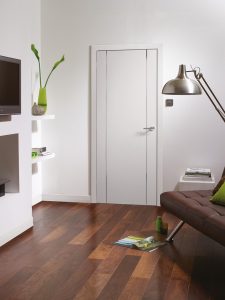Every non-domestic building in the UK has to have fire doors installed somewhere in the property. England and Wales building regulations use different parts of Approved Documents to give guidance on how to meet and abide by the legislation for new build properties. The Regulatory Reform (Fire Safety) Order 2006 outlines the guidance and legislation for existing buildings.
Table of contents:
- Where are fire doors needed in non-domestic buildings?
- Who’s responsible for fire doors in non-domestic buildings?
- Fire door maintenance and inspections in non-domestic buildings
Where are fire doors needed in non-domestic buildings?
For non-domestic buildings, the Regulatory Reform (Fire Safety) Order 2006, known as FSO, sets out guidance depending on vertical or horizontal escape routes from the building. This should be assessed on a case-by-case basis depending on the quickest and safest egress from the property. Fire doors should line this route as a minimum requirement. The necessary ratings of those fire doors are usually specified in regard to their position, what’s surrounding them and the nature of the building.
FD30 and FD60 are the most commonly specified fire doors that offer 30 minutes and 60 minutes of fire resistance respectively. If 30 minutes is deemed as enough time for the building to evacuate then usually these doors are specified. If not then FD60 is often required. In cases of protected or listed buildings too then FD60 may be specified as a way of preserving parts of the building should a fire break out. Saving lives always comes first though.
A very common fire door placement is a hotel room door. Each of these must be fire rated to FD30.
Who’s responsible for fire doors in non-domestic buildings?
The aforementioned FSO states that there should be a ‘responsible person’ for each building that’s responsible for carrying out a fire safety risk assessment and implementing a fire management plan. They will be responsible for ensuring that this is all up to date and includes all aspects of the building, including extensions and outbuildings. This individual is also responsible for fire door maintenance and ensuring they’re installed and kept to the given standard. The ‘responsible person’ law applies to you if you are:
- Responsible for business premises or you’re an employer/self-employed with business premises.
- A charity or voluntary organisation.
- A contractor with a degree of control over any premises or if you’re responsible for any part of a building that is solely used for business purposes.
- Providing accommodation for paying guests.
The first concern for any ‘responsible person’ should be fire doors and the condition that they’re in. This includes the ironmongery, hardware, smoke seals and maintenance.
With any changes of use in a building or any extension/development works the role of ‘responsible person’ is passed over to the contractor and as such, when the building is passed back, they must provide a detailed and accurate fire safety information pack under Regulation 38 of FSO. All fire safety design measures must be detailed as much as possible to allow the new ‘responsible person’ to maintain and operate the building safely. This information must include all information pertaining to the fire door assembly.
Fire door maintenance and inspections in non-domestic buildings
If a fire door is damaged or any part of the fire door set (including ironmongery, hardware and smoke seals) is damaged then in the event of a fire the fire door won’t perform like it’s supposed to. This will jeopardise lives so fire doors should be regularly inspected by the ‘responsible person’ or a certified professional. The condition of fire doors and any fire doors that are awaiting maintenance to get them to the correct standard should be taken into account and amended in the fire safety risk assessment.
If a fire door is faulty or something is amiss, like the door not closing into its fire door frame properly, then this should be documented and fixed as soon as feasibly possible. It’s worth double-checking too that replacement parts are compatible with the existing fire door set by checking the fire certificate data sheet that comes with all fire-tested components. We recommend carrying out a fire door inspection once every six months but increasing this if one door experiences particularly high traffic or is in constant use. FSO as legislation denotes regular inspection and adequate maintenance as a legal requirement.
Use this fire door maintenance checklist from BWF to help you if you’re the ‘responsible person’.
You may also be interested in:














